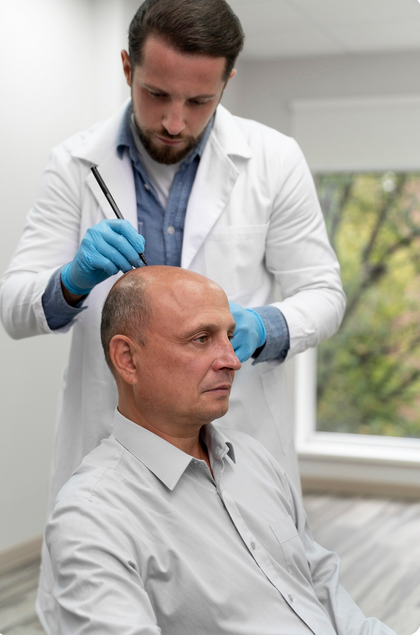Hair loss can be a significant source of distress, affecting not only your appearance but also your confidence and quality of life. Fortunately, advances in hair transplant technology have made it possible to restore a natural-looking hairline and fuller hair with permanent, effective results. Among the most popular methods are Follicular Unit Extraction (FUE) and Follicular Unit Transplantation (FUT).
If you’re considering hair restoration, understanding the differences, procedures, benefits, and recovery for FUE and FUT hair transplants can help you make an informed choice.
What Is Hair Transplant Surgery?
Hair transplant surgery involves relocating healthy hair follicles from a donor area (usually the back or sides of the scalp) to areas affected by hair loss or thinning. These transplanted follicles grow hair naturally in their new location, providing a permanent solution to hair loss.
Understanding FUE and FUT Methods
Follicular Unit Extraction (FUE)
- FUE involves harvesting individual hair follicles one by one directly from the donor area using a tiny punch tool (0.7–1.0 mm in diameter).
- The follicles are then transplanted to the thinning or bald areas.
- This technique leaves minimal scarring—small dot-like marks that are barely noticeable.
- FUE is favored for its minimally invasive nature and faster recovery.
Follicular Unit Transplantation (FUT)
- FUT, also known as the strip method, involves removing a strip of scalp tissue from the donor area.
- The strip is dissected under a microscope into individual follicular units, which are then transplanted.
- The donor site is sutured, leaving a linear scar that is usually concealed by surrounding hair.
- FUT allows for harvesting a larger number of grafts in one session, making it suitable for extensive hair loss.
Which Method Is Right for You?
| Feature | FUE | FUT |
|---|---|---|
| Scarring | Minimal, dot-like scars | Linear scar |
| Recovery Time | Faster (few days) | Slightly longer (1–2 weeks) |
| Graft Quantity | Moderate | Higher graft count per session |
| Suitability | Ideal for smaller to moderate areas | Suitable for larger transplant areas |
| Post-op Discomfort | Less discomfort | More discomfort due to sutures |
| Cost | Slightly higher due to labor intensity | Slightly lower |
Your surgeon will recommend the best approach based on your hair loss pattern, donor area condition, and personal preferences.
The Hair Transplant Procedure: What to Expect
1. Consultation and Planning
Detailed assessment of hair loss, donor area, scalp condition, and expectations. Customized hairline design and treatment plan are developed.
2. Donor Hair Harvesting
- FUE: Individual follicles extracted using micro punches.
- FUT: Scalp strip removed and dissected.
3. Recipient Site Preparation
Tiny incisions are made in the balding area to receive the grafts.
4. Graft Placement
Follicular units are carefully implanted to mimic natural hair growth direction and density.
5. Post-Procedure Care
Instructions on scalp care, medications, and activity restrictions are provided.
Recovery Timeline
- First 1–3 days: Mild swelling, redness, and scabbing in donor and recipient areas.
- 1 week: Most scabs fall off, and stitches (FUT) are removed.
- 2 weeks: Visible signs of surgery subside; normal activities can be resumed.
- 2–3 months: Transplanted hair may shed (normal “shock loss”).
- 4–6 months: New hair begins to grow.
- 9–12 months: Full results visible with thicker, natural hair growth.
Benefits of Hair Transplantation
- Permanent solution to hair loss using your own hair.
- Restores natural hairline and density.
- No need for daily medications or topical treatments.
- Boosts self-confidence and appearance.
- Can be combined with other treatments like PRP for enhanced results.
Who Is a Candidate for Hair Transplant?
Ideal candidates:
- Have sufficient donor hair density at the back/sides of the scalp.
- Are in good general health.
- Have realistic expectations about outcomes.
- Are experiencing androgenetic alopecia or other types of hair loss.
- Are not suffering from active scalp infections or diseases.
Hair Transplant in Korea: Why Choose It?
- Highly skilled surgeons specializing in FUE and FUT techniques.
- Access to advanced technology such as robotic FUE and digital planning.
- Competitive pricing compared to Western countries.
- Clinics catering to international patients with multilingual support.
- Integration with medical tourism for a comfortable, well-supported experience.
Final Thoughts
Hair transplant surgery, whether FUE or FUT, offers a life-changing opportunity to restore your hair and confidence. By understanding the procedures, benefits, and recovery process, you can take the first step toward a fuller, natural-looking head of hair.




